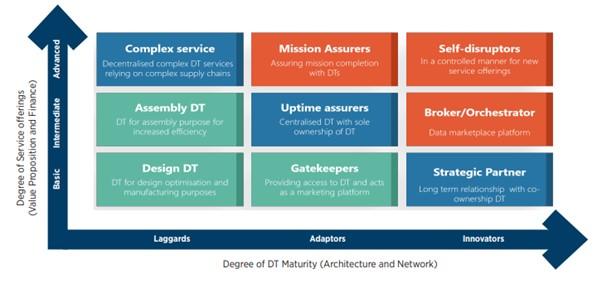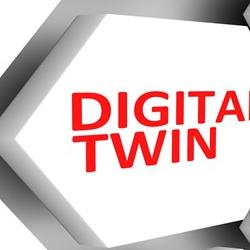
The bigger and more complicated the engineering problem, the more likely it is to have a digital twin. Firms that build rockets, planes and ships, for example, have been creating digital twins since the early 2000s, seeing significant operational efficiencies and cost-savings as a result. To date, however, few firms have been able to realise the full potential of this technology by using it to develop new value-added services for their customers. This project developed a framework designed to help scale the value of digital twins beyond operational efficiency towards new revenue streams.
Digital twins and business model innovation can be seen in aviation, automation and, more recently, construction. What are the potential advantages of creating digital twins for established organisations in these sectors? Do digital twins act as drivers to support new business models? And what steps are necessary to derive value from business model innovation? CDBB researchers undertook a cross-sector investigation to generate and share learning and good practice. The focus was not on the technology, but what the technology can deliver—for businesses and for their customers.
Process
Researchers began by developing a business model taxonomy related to digital twin products and services, informed by a literature review. At this stage, the researchers identified pathways to change driven by digital twin adoption, forces driving change, and the key elements of a digital twin-enabled business model that provide the basis of the final framework.
Researchers then conducted interviews with senior business managers and C-suite executives from large multi-national firms in a range of industries: defence, aviation, automotive, chemical engineering, transportation and manufacturing. The interview questions focused on digital twin services and business models, testing the initial framework. The 31 interviewees were all senior managers, drawn from 21 mostly-multinational companies, spanning a wide range of sectors and geographies. Analysis of their responses generated indicative business models, categorised in terms of service level and the maturity of their digital twin offer.
A third phase of work surveyed representatives from 100 organisations. Again, questions were designed to test and validate the framework, while gauging the responses of a wider pool of participants all of whom are engaged in implementing digital twins.
The validated framework is available for B2B service providers to consult, with related training and workshops available via the Cambridge Service Alliance.
Key findings
Digital twins facilitate three pathways to change
- From dependency to autonomy: Digital twins can understand, learn and react autonomously.
- From ignorance to insight: Through continuous insight into the performance of their physical counterparts, digital twins facilitate real-time improvement.
- From inaccuracy to fidelity: The essential level of fidelity is sector-specific, with high fidelity required in manufacturing where data may trigger action without human intervention.
Digital twins also align with other forces driving innovation in business models
- From products to services: Digital twins have a critical role in servitisation, creating opportunities to add value throughout an asset’s life cycle.
- From efficiency to agility: Digital twins permit increased attention to customisation, meeting the needs of diverse end-users.
- From separation to fusion: Connecting the virtual and real worlds, digital twins can revolutionise customer experience.
The 4Vs Framework
Designed to assist industry decision-making, the 4Vs Framework covers: the value proposition for the product or service being offered; the value architecture or the infrastructure that the firm creates and maintains in order to generate sustainable revenues; the value network representing the firm’s infrastructure and network of partners needed to create value and to maintain good customer relationships; and value finance such as cost and revenue structures.
Industry-facing summaries from each stage of the research have been shared with Cambridge Service Alliance’s Community of Interest and in other CSA publications. These include an overview (2020), a feature on business model archetypes (March 2021), and digital twins and new services (CSA Annual Review 2021). Dr Pärn has also shared insights from the ongoing work in her podcast, Beyond BIM. Episodes are available on Soundcloud, with the full series also available on YouTube. Further publications are anticipated.
So what?
For B2B service-providers looking to generate new revenue from their digital twins, it is important to consider how the business model should be configured and identify major barriers to their success.
Industry impact
The researchers found that one of the most significant barriers to generating revenue from digital twins was a lack of buy-in from business leaders. The 4Vs Framework has been designed to help those leaders arrive at a better understanding of the business opportunities digital twin services can provide. The Framework should drive innovation and help digital twins realise their full business potential.
The researchers worked closely with industry partners, drawing on the Cambridge Service Alliance membership. The interest in this work has been significant. For example, 75 executives from different industries attended a Cambridge Service Alliance workshop on Digital Twins and Business Models in April 2021. Dr Erika Pärn and Dr Michael Grieves introduced the key concepts and presented the framework, providing an opportunity for participants to model their own organisations using a 4Vs card. Such proactive engagement provided fresh data for the researchers and supported the validation process, ensuring findings speak to industry needs.
During the research period, Dr Pärn shared work-in-progress with external audiences including at the Frontiers in Service conference in Boston, USA (23-24 June 2022; topic: Servitisation Business Models of Digital Twins). She was an invited keynote speaker at the American Society of Mechanical Engineers’ Digital Twin Summit 2021, and the Artificial Intelligence in Architecture, Engineering and Construction conference in March 2021.
"Research into Business Model Innovation with Digital Twins is both a timely and important area of research to HCL and its customers, we see great value and synergy in this research work undertaken by Dr. Parn.”
Ahmed Soliman, Strategic Development Director, HCL Technologies
Wider benefits
At inception, the research was intended to identify learning relevant to the construction sector by scrutinising what is happening in other industries from a business models perspective. In practice, the researchers found a wider appetite for expertise concerned with the relationship between digital twins and business model innovation. The findings are therefore presented in a manner that all sectors can learn from.
All research findings have been shared through the National Digital Twin programme (NDTp) run by the Centre for Digital Built Britain (CDBB) Digital Framework Task Group (until March 2022) and now curated by the DT Hub. Cited by the National Infrastructure Commission as having the potential to unlock an additional £7 billion per year of benefits across the UK infrastructure sector, the NDT will support better decision-making to enable a sustainable, zero carbon and resilient economy and society for all.
Dr Pärn participated in Tallinn Digital Summit 2021, as a guest of the Estonian prime minister; her co-authored study of the Estonian city of Tallinn’s digital twin is published as Chapter 8 in Väyrynen et al, Public Innovation and Digital Transformation (Routledge, 2023), applying the 4Vs model to public infrastructure. This application is an effective reminder that the relationship between business model innovation and digital twins is not confined to commercial contexts or narrow definitions of industry.
Collaborators
Throughout the research the project has been supported by members of the Cambridge Service Alliance. Notable industry partners include:
- HCL Technologies (turnover $10.17B in 2021)
- Caterpillar ($43B turnover in 2021)
- Cemex (annual turnover $14.5B at last report)
- Bouygues (member since 2021; turnover €12B in 2020)
Innovation
The construction sector is a tangible and asset-heavy industry often criticised for its low productivity and slow approach to technology adoption. In the UK, the sector has begun to receive intensive investment in intangible assets and digital services, yet it still lags a decade behind manufacturing industry investment in digital transformation. A common criticism of the construction sector has been that few practitioners seek guidance from more technologically-advanced sectors, such as retail, aerospace and automotive manufacturing, particularly with respect to improving productivity. Surveying current practices cross-sector and the implementation of digital twins, this CDBB research project has provided an important corrective.
The researchers worked with two other CDBB projects exploring barriers and innovation, yielding insights relevant to policy and with special reference to off-site manufacturing:
- Facilitating the digitisation of off-site manufacturing
- Analysing the social context to transforming construction through digital innovation
Joint outputs from these and other CDBB research can be discovered in the Knowledge Base Navigator.

